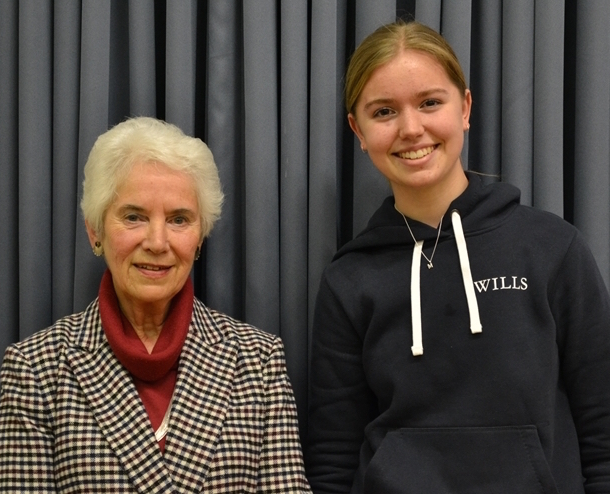Religious Studies at the Senior School
Year 10 Day of Reflection - encourgaing debate
‘Where Do You Stand?’ is an activity we usually run during the morning of the Year 10 Day of Reflection. A variety of aphorisms, urban truths, religious and philosophical truths are called out and the whole year group move to different points along a line stretching the length of the hall, depending on how far they agree or disagree with the statement.
“The pen is mightier than the sword,” “Angels exist,” “The voting age should be lowered to 16,” “Mother knows best,” “Tax the rich to support the poor,” “War can never be justified,” “I believe in love at first sight” ...
After some of the more significant or contentious statements the process is paused for discussion, hearing contributions from those standing at different points on the spectrum. The final statement we invite the students to consider is always the same – “Religion should be taught in schools. Agree or disagree?”
The frank discussion which follows is always full of understandable contradictions. There is some negativity about lack of choice when Religious Studies is compulsory throughout school; there are concerns about the possibility of indoctrination in certain educational settings (not at St Mary’s)!
On the other hand, our fifteen-year-olds are also more aware than some Oxford professors I could mention of the need for religious literacy, not just to be religious but to understand much of the context of history, literature and culture, and to reach an appreciation and an understanding of the other which is, at least, an antidote to prejudice and intolerance and, at best, incredibly enriching on a personal and cultural level.
Embracing nuance
Religious Studies gets one used to contradictions. It is an important point of realisation for students that the certainties of faith do not necessarily bring about certainty or uniformity – despite what textbooks seem to imply, not all Muslims do X and not all Jews follow the laws on Y. Variations of personal belief and degrees of observance are in all communities.
It is a subject where we have addressed issues which are very contemporary – drone strikes, inequality, the law on assisted dying, religious freedom, multiple universe theory in cosmology. It is a subject which is very ancient – when Years 9 and 10 consider Abraham they are looking at a figure from about 1800 BCE; when we study Hinduism, or look briefly at Zoroastrianism in the Sixth Form, we are going back further than that.
These things are somehow distant and close by, local and universal. Abraham, the Patriarch of the Jews, and by association Christianity and Islam, came from Ur of the Chaldeans, and his tribe/family worshipped moon gods. In the Fitzwilliam Museum in Cambridge, quite by chance as I was passing a display case in a corridor, I came across a little figurine which was labelled as Moon god from Ur c.1800 BCE.
In the final term of Year 7, we learn something of the beliefs, practices and traditions of Hinduism. Worship in Hindu traditions can be very colourful and engages the senses, and traditional architecture in Indian temples is striking and remarkable; we are lucky to be able to experience both each year, but in Neasden, at the Swaminaryan Mandir near to IKEA in Wembley. And now we have a new eco-Mosque, with a modern take on a traditional style, on Mill Road.
 Sixth Form - Philosophy, Ethics and Religion
Sixth Form - Philosophy, Ethics and Religion
As part of the Sixth Form PER programme, it was a privilege to welcome back to St Mary’s, Eva Clarke, a Holocaust survivor who was born in Mauthausen concentration camp, weeks before the end of the war, especially given the 75th anniversary of liberation passing this year:
It is an extraordinary and powerful occasion when events so infamous as a terrible part of our continental, and indeed universal, history are standing, personal and individual, in the room and talking with us.
Another visiting contributor to the PER programme was St Mary’s alumna and archaeologist of St Catherine’s College, Dr Emily Hallinan. Emily helped students and staff to consider evidence for the very first emergence of religious ritual among early humans. Our narrative of understanding sacred space, use of symbol, and ritual acts may go back nearly 100,000 years.
And finally ... hope
A couple of months after the lesson given by Emily Hallinan, we are trying to adjust to the stresses and demands of remote teaching in lockdown. One of my colleagues sends an email to the rest of the RE Department: he has just had a good lesson with his Year 11 class, a really good discussion, which is quite an achievement in the remote set up.
The topic at the end of the GCSE course is Human Rights and my colleague is thankful to be teaching a subject which can be so relevant to contemporary events. The class got carried away discussing how far the lockdown measures enacted by the government are an infringement of individual rights, and how far individual rights can be curtailed for the protection of others.
My colleague’s email was titled simply ... ‘Hope’.
Return to Magnolian 2020